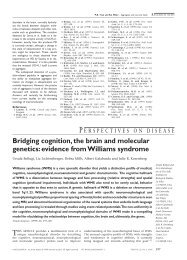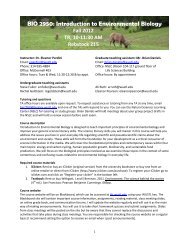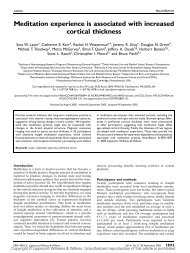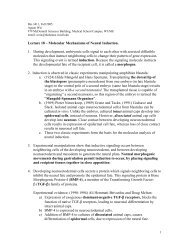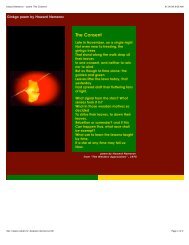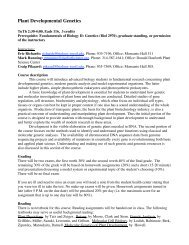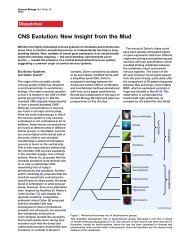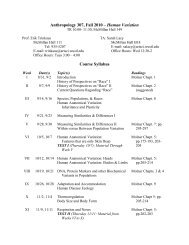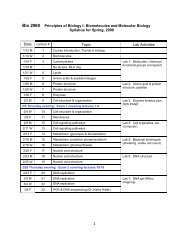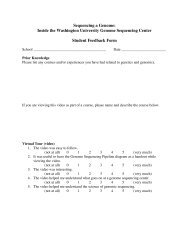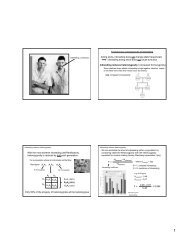Report The Matrilineal Ancestry of Ashkenazi Jewry: Portrait of a ...
Report The Matrilineal Ancestry of Ashkenazi Jewry: Portrait of a ...
Report The Matrilineal Ancestry of Ashkenazi Jewry: Portrait of a ...
Create successful ePaper yourself
Turn your PDF publications into a flip-book with our unique Google optimized e-Paper software.
Table 3Source and Ethnic Origin <strong>of</strong> the 121 CompletemtDNA SequencesSample a Source PopulationD5939 Present article Algerian JewD1123 Present article <strong>Ashkenazi</strong> JewD1139 Present article <strong>Ashkenazi</strong> JewD1282 Present article <strong>Ashkenazi</strong> JewD1369 Present article <strong>Ashkenazi</strong> JewD1606 Present article <strong>Ashkenazi</strong> JewD1829 Present article <strong>Ashkenazi</strong> JewD4207 Present article <strong>Ashkenazi</strong> JewD4232 Present article <strong>Ashkenazi</strong> JewD4262 Present article <strong>Ashkenazi</strong> JewD4481 Present article <strong>Ashkenazi</strong> JewD4777 Present article <strong>Ashkenazi</strong> JewD5551 Present article <strong>Ashkenazi</strong> JewD5677 Present article <strong>Ashkenazi</strong> JewD5077 Present article CherkesD1311 Present article DruzeD1320 Present article DruzeD1626 Present article DruzeD1701 Present article DruzeD1520 Present article Moroccan JewD5908 Present article Moroccan JewD5257 Present article PalestinianD1435 Present article Yemenite JewD1656 Present article Yemenite JewD4757 Present article Yemenite JewE1089 Present article LebaneseE1221 Present article SaudiE1365 Present article SyrianA Achilli et al. 2005 ItalianH Herrnstadt et al. 2002 UnknownF Finnila et al. 2001 FinnishK Coble et al. 2004 UnknownMa Maca-Meyer et al. 2001 IberianMi Mishmar et al. 2003 UnknownP Palanichamy et al. 2004 IndianaSerial numbers <strong>of</strong> mtDNAs from the literaturewere not changed.elsewhere in the same U.S. data set (Herrnstadt et al.2002).After the delineation <strong>of</strong> the Hg K topology and in asearch for clues regarding the possible origin <strong>of</strong> the <strong>Ashkenazi</strong>lineages, 789 Hg K mtDNAs <strong>of</strong> a global set <strong>of</strong>13,359 samples (tables 5 and 6) were hierarchicallyscreened for polymorphisms relevant to include or excludethe samples from the three <strong>Ashkenazi</strong> K subbranches—K1a1b1a,K1a9, and K2a2a. <strong>The</strong> position <strong>of</strong>the three dominant <strong>Ashkenazi</strong> founding sequenceswithin the phylogenetic tree <strong>of</strong> 789 Hg K genomes isillustrated in figure 2. Of the 182 <strong>Ashkenazi</strong> Hg KmtDNAs, 179 could be readily assigned to K1a1b1a,K1a9, or K2a2a (table 6), demonstrating that virtuallyall Hg K genomes present in the <strong>Ashkenazi</strong> Jews belongto these three distinct monophyletic clades and, in turn,comprise 30% <strong>of</strong> all <strong>Ashkenazi</strong> maternal lineages. Of123 K1a1b1a mtDNAs (fig. 2 and table 6), 122 werefrom Jews—113 <strong>of</strong> <strong>Ashkenazi</strong> and 9 <strong>of</strong> Spanish-exileancestry (6 Bulgarian, 2 Italian, and 1 Turkish). <strong>The</strong> onlynon-Jewish K1a1b1a mtDNA that shared the HVS-Ihaplotype 16223-16224-16234-16311 with the <strong>Ashkenazi</strong>Jews was found in a subject from Hmelnitski, aUkrainian town with a major Jewish settlement until theSecond World War. As for K1a9, 48 <strong>of</strong> the 789 KmtDNAs were members <strong>of</strong> this subHg (fig. 2 and table6), and 47 were from Jews—41 <strong>Ashkenazi</strong>, 4 Spanishexile (2 Bulgarian, 1 former Yugoslavian, and 1 fromTurkey), 1 from Iraq, and 1 from Syria. A subHg K1a9mtDNA was found in one Hungarian <strong>of</strong> unidentifiedethnic or religious affiliation. Finally, 28 (25 <strong>Ashkenazi</strong>Jews, 1 Bulgarian Jew, 1 Georgian Jew, and 1 AzerbaijaniJew) <strong>of</strong> the 789 K samples belonged to subHg K2a2a(fig. 2 and table 6). This subHg and its parental Hg werenot found in any <strong>of</strong> 11,452 non-Jewish samples.<strong>The</strong> same principles were followed to investigate thehigh incidence <strong>of</strong> Hg N1b in <strong>Ashkenazi</strong> Jews. Hg N1bis virtually absent in Europeans but appears at frequencies<strong>of</strong> ∼3% or higher in those from Levant, Arabia, andEgypt (Richards et al. 2003; Kivisild et al. 2004; unpublishedresults <strong>of</strong> Tartu and Haifa groups). This Hgis defined by the transversion C16176G, relative to therevised Cambridge Reference Sequence (rCRS) (Andrewset al. 1999), and is reported in all non-Jewish Near EasternN1b mtDNAs. However, all but one <strong>of</strong> the <strong>Ashkenazi</strong>N1b mtDNAs were found to harbor a CrA transversionat nucleotide position 16176. To assess whetherthis was another <strong>Ashkenazi</strong> founding lineage, we followedthe same approach applied to Hg K. We randomlychose two mtDNAs for complete sequencing and identifiedseveral shared mutations that were absent in apreviously reported N1b complete sequence (Maca-Meyer et al. 2001) (fig. 3). We then examined nucleotidepositions 11928 and 12092—sites <strong>of</strong> two <strong>of</strong> the privatemutations—in 82 N1b mtDNAs that were available tous (table 7). Fifty-six <strong>of</strong> the 57 <strong>Ashkenazi</strong> Jews, the Spanish-exileJews, and the Moroccan Jew, who shared16176A, could be assigned to this same lineage. <strong>The</strong>single <strong>Ashkenazi</strong> and all other mtDNAs with 16176Gdid not harbor the mutations at 11928 and 12092. Curiously,the 16176A transversion probably occurredtwice in the phylogeny <strong>of</strong> N1b. Indeed, we have foundlineages with 16176A in Slavic-speaking populationsboth in the Balkans and in Ukraine, but these possessedHVS-I mutations different from those present among theJews, and they did not harbor the mutations at 11928and 12092; thus, they are clearly phylogenetically distinctfrom N1b genomes <strong>of</strong> the <strong>Ashkenazi</strong> Jews.In total, we have identified four <strong>Ashkenazi</strong> foundinglineages, three within Hg K and one in Hg N1b, derivingfrom only four ancestral women and accounting for fully40% <strong>of</strong> the mtDNAs <strong>of</strong> the current <strong>Ashkenazi</strong> popu-www.ajhg.org Behar et al.: <strong>Portrait</strong> <strong>of</strong> a Founder Event 489



